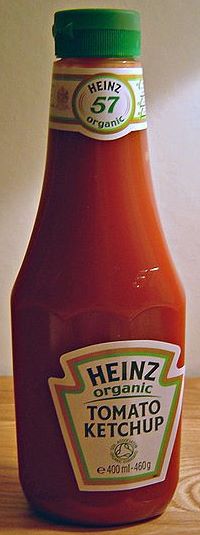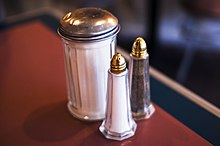Condiment: Difference between revisions
m Reverted 2 edits by 66.33.248.246. (TW) |
No edit summary |
||
| Line 4: | Line 4: | ||
A '''condiment''' is a prepared edible [[Chemical substance|substance]] or [[mixture]], often [[Food preservation|preserved]] or [[Fermentation (food)|fermented]], that is added in variable quantities, most often at the table, to make food more suitable to the diner's taste.<ref>{{cite book |last=McGee |first=Harold |authorlink=Harold McGee|title=On Food and Cooking |year=2004 |publisher=Scribner |location=New York |isbn=0-684-80001-2}}</ref> Some condiments are dry such as a mixture of [[seasoned salt|herbs and seasonings]] or [[Parmesan cheese]], however many are preserved [[sauce]]s that have been put into a bottle, jar, or other container. For convenience, some condiments are provided in single-serving packets often with [[take-out]] foods. |
A '''condiment''' is a prepared edible [[Chemical substance|substance]] or [[mixture]], often [[Food preservation|preserved]] or [[Fermentation (food)|fermented]], that is added in variable quantities, most often at the table, to make food more suitable to the diner's taste.<ref>{{cite book |last=McGee |first=Harold |authorlink=Harold McGee|title=On Food and Cooking |year=2004 |publisher=Scribner |location=New York |isbn=0-684-80001-2}}</ref> Some condiments are dry such as a mixture of [[seasoned salt|herbs and seasonings]] or [[Parmesan cheese]], however many are preserved [[sauce]]s that have been put into a bottle, jar, or other container. For convenience, some condiments are provided in single-serving packets often with [[take-out]] foods. |
||
Condiments are usually served as a supplement to a larger dish as a topping. They may be served ''on the side'' or as a [[garnish (food)|garnish]], like [[sauerkraut]], which can be used as a bed for Schweinshaxen (pork knuckles) or as a topping for a hot dog. When served separately, the amount is usually at the diner's discretion, however condiments may be added prior to serving, for example a [[deli]] sandwich made with [[mayonnaise]] |
Condiments are usually served as a supplement to a larger dish as a topping. They may be served ''on the side'' or as a [[garnish (food)|garnish]], like [[sauerkraut]], which can be used as a bed for Schweinshaxen (pork knuckles) or as a topping for a hot dog. When served separately, the amount is usually at the diner's discretion, however condiments may be added prior to serving, for example a [[deli]] sandwich made with [[mayonnaise]] or [[mustard (condiment)|mustard]], a hybrid of the two known as mayostard or mustardayonnaise, or even a combination of the two hybrids called mustmayostardayonnaise. Some condiments may also be used during cooking to add flavor or texture to the food; for example, [[barbecue sauce]], [[teriyaki sauce]], and [[soy sauce]] all have flavors that can enhance the tastes of a variety of different meats and vegetables. Bacon or bacon bits can be perceived as condiments at some restaurants.{{Fact|date=March 2008}} |
||
Although sometimes considered a condiment, [[salt]] is more strictly considered as a [[seasoning]], as salt does not come 'prepared' like most condiments do.{{Fact|date=March 2008}} |
Although sometimes considered a condiment, [[salt]] is more strictly considered as a [[seasoning]], as salt does not come 'prepared' like most condiments do.{{Fact|date=March 2008}} |
||
Revision as of 17:24, 15 July 2008


A condiment is a prepared edible substance or mixture, often preserved or fermented, that is added in variable quantities, most often at the table, to make food more suitable to the diner's taste.[1] Some condiments are dry such as a mixture of herbs and seasonings or Parmesan cheese, however many are preserved sauces that have been put into a bottle, jar, or other container. For convenience, some condiments are provided in single-serving packets often with take-out foods.
Condiments are usually served as a supplement to a larger dish as a topping. They may be served on the side or as a garnish, like sauerkraut, which can be used as a bed for Schweinshaxen (pork knuckles) or as a topping for a hot dog. When served separately, the amount is usually at the diner's discretion, however condiments may be added prior to serving, for example a deli sandwich made with mayonnaise or mustard, a hybrid of the two known as mayostard or mustardayonnaise, or even a combination of the two hybrids called mustmayostardayonnaise. Some condiments may also be used during cooking to add flavor or texture to the food; for example, barbecue sauce, teriyaki sauce, and soy sauce all have flavors that can enhance the tastes of a variety of different meats and vegetables. Bacon or bacon bits can be perceived as condiments at some restaurants.[citation needed]
Although sometimes considered a condiment, salt is more strictly considered as a seasoning, as salt does not come 'prepared' like most condiments do.[citation needed]
Condiment gallery
-
Salsa verde, salsa roja
-
Dijon mustard
-
Packets of duck sauce
-
American Steak sauce
-
British Brown sauce
-
Sriracha chili sauces
-
Grated American parmesan cheese
-
A tube of prepared wasabi
See also
References
- ^ McGee, Harold (2004). On Food and Cooking. New York: Scribner. ISBN 0-684-80001-2.





